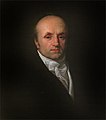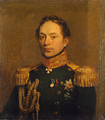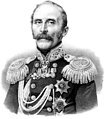Hajji Murat (Lev Tolstoy)

Hadschi Murat ( Russian Хаджи-Мурат , transcription: Chadschi-Murat , transliteration: Chadži-Murat ) is a short story by Lev Tolstoy , which was written in the years 1896–1906 and published posthumously in 1912. Tolstoy used the memories of the second lieutenant and later general Vladimir Alexejewitsch Poltorazki as well as the adjutant and later count Mikhail Loris-Melikow . This is Tolstoy's last work.
It tells episodes from the last months of the life of the Avar Muslim Hajji Murat , a fickle fighter of the Chechens against the military in the empire of Nicholas I.
content
Late autumn 1851 to May 5, 1852 in Chechnya and Dagestan in the eastern Caucasus : In November 1851, Hajji Murat - on the run from the Murid Shamils - found accommodation with one of his followers in a Chechen Aul near the Argun . Those who give shelter to Hajji Murat face the death penalty. The newcomer was watched by a villager. Shamil wants him alive or dead. The men in the aul want to arrest Haji Murat. After the three days of persecution, the refugee wants to sleep in. He believes in his luck. If Hajji Murat defected to Prince Semyon Mikhailovich Vorontsov, he could take to the field against Shamil and take power in Avari and all of Chechnya. He's sending out a messenger. Vorontsov wants to receive Haji Murat like a guest. Hadschi Murat evades the threat of arrest by the Chechens in the village by daring to flee and submits to Prince Vorontsov. The latter is the son of the imperial governor in Tbilisi . The report of Hajji Murat's conversion was received in Tbilisi on December 7, 1851.
Hajji Murat is escorted to Tbilisi and tells the Russians there that Shamil is persecuting him because he does not want to fight the tsar. Hajji Murat assured the governor that he wanted to fight Shamil under Russian leadership to the last drop of blood, but he had to wait for now. Shamil is keeping Haji Murat's family - the wife, mother and six children - in the mountains and will kill his family as soon as Haji attacks Murat. Some officers on the staff of the governor of Tbilisi suspect that the defector is trying to deceive them; all that mattered to him was the investigation of the weak points in the Russian positions.
The defector is not trusted. Because Haji Murat fought both with the Russians and against them. Adjutant Loris-Melikow is told about Hajji Murat's life. It turns out that Shamil had killed Hajji Murat's brother. Therefore, Hajji Murat became an ensign with General Rosen . One of Hajji Murat's mortal enemies served in the Russian troops: Akhmet Khan. He had shed a woman in vain and came to the conclusion that Hajji Murat had thwarted the advertising. Akhmet Khan had now captured Ensign Hajji Murat at the first opportunity. The prisoner had managed to escape and from then on he had fought against the Russians under Shamil because he wanted to get revenge on Akhmet Khan. But there was a dispute between Shamil and Hajji Murat over the share of the booty. On the one hand Shamil needed Hajji Murat as an agile fighter and on the other hand he wanted to get rid of him as a dangerous competitor for the office of Imam . Haji Murat must fear for his life, flees and is persecuted by the Shamil murids, as outlined above.
On December 20, 1851, the Tbilisi governor Vorontsov wrote a letter to Minister of War Chernyshev on the Hajji Murat affair . The latter addressed the tsar on January 1, 1852. Nicholas I endorses Vorontsov's suggestion - Haji Murat should be used against the enemy. The enemy - that is Shamil. Hajji Murat assigns faithful people to free his family while Shamil fights in the field. Shamil's father-in-law thwarted the venture. The hostages are brought to Wedeno. Shamil lures Haji Murat to Vedeno. Hadji Murat's son Yusuf had to write his father a letter. If Hadji Murat not to Beiram is firmly Vedeno, Yusuf is chopped off the head and Yussef's mother and grandmother are as fair game hunted by the Aule. Shamil corrects himself. He will treat Yusuf like a traitor - have his eyes gouged out.
Yusuf wants to stab himself. That fails. He is being returned to his prison - a pit.
Hajji Murat begs the governor Voronzow in Tbilisi in vain to exchange captured mountain residents for his family. He is transferred to Nucha - with the intention of freeing his family. Vorontsov calls Haji Murat to a meeting in Tbilisi on April 12, 1852. But Haji Murat flees. He wants to free his family on his own. The escape ends in a flooded rice field. Hajji Murat is surrounded and shot.
history
Tolstoy mentions a number of historical personalities or brings them into play. Most of them are not mentioned in the short summary above.
The figures of the personalities are arranged according to their mention in Tolstoy's story.
Shamil (1797–1871)
Emperor of Russia Nicholas I (1796-1856)
Abraham Breguet (1747–1823) Swiss watchmaker
Viceroy of the Caucasus Michail Voronzow (1782-1856), Russian governor in Tbilisi
Joachim Murat (1767–1815), King of Naples under Napoleon
Count Michail Loris-Melikow (1824–1888)
Kasi Mulla (1794–1832), first imam in Chechnya and Dagestan
General Georg Rosen (1776–1841) in 1826
Minister of War Prince Alexander Chernyshev (1786–1857) in 1851
Prince Vasily Dolgorukov in the 1850s
King of Prussia Friedrich Wilhelm IV. (1795–1861) in 1847
Grand Duchess Helena Pavlovna of Russia (1807–1873) in 1872
Grand Duke Michael Pawlowitsch Romanow (1798–1849) in 1845
General Alexei Petrovich Jermolow (1777–1861) around 1843
Prince Pyotr Mikhailovich Volkonsky (1776-1852)
Governor General of the Baltic Provinces Baron Wilhelm Lieven (1800–1880)
Count Rzewuski (1791–1866)
Field Marshal Alexander Ivanovich Baryatinsky (1815–1879)
shape
The late text - revised nine times - is of perfect form. At first glance, there is a jagged corpus, because the scenes of the action are cheerfully changed in the 25 chapters. In addition to the back and forth in the Caucasus, the 15th chapter leaps to Saint Petersburg . A form feature that is difficult to overlook can be demonstrated on the basis of the last-mentioned chapter. In this 15th chapter, Lev Tolstoy not only offers the tsar's reaction to the turning point in the Caucasus War, caused by Haji Murat's surprising change of front, but also paints a three-dimensional picture of Nicholas I with just a few strokes. Russian attacks on the mountain peoples are initially out of sight the attacker is portrayed as an entertaining ride that can also cost a few Russians their lives. Afterwards, the whole horror of the war from the perspective of the victims (the civilian population is also affected) and the destruction of the village's habitat that has grown over many years is not concealed. This creates believable images.
German-language editions
- Haji Murat. First German translation in 1912 by August Scholz , S. Fischer Verlag, Berlin
- Haji Murat. German by Arthur Luther . Pp. 89–240 in: Gisela Drohla (Ed.): Leo N. Tolstoj. All the stories. Seventh volume. Insel, Frankfurt am Main 1961 (2nd edition of the edition in eight volumes 1982)
- Haji Murat. Translated from the Russian by Hermann Asemissen . Pp. 5–161 in: Eberhard Dieckmann (Ed.) Lew Tolstoi. Haji Murat. Late stories (contains: Hajji Murat. After the ball. The fake coupon. Alyosha the pot. What for? The divine and the human. What I saw in dreams. Father Vasily. Power of the child. The monk-priest Iliodor. Who are the murderers? Conversation with a stranger. The stranger and the farmer. Songs in the village. Three days in the country. Children's wisdom. Grateful soil. Chodynka. Unwanted. Post-legacy records of the monk Fyodor Kuzmich. All the same. There are no guilty parties in the world ). 623 pages, vol. 13 by Eberhard Dieckmann (ed.), Gerhard Dudek (ed.): Lew Tolstoi. Collected works in twenty volumes . Rütten and Loening, Berlin 1986 (edition used)
- The stories. Vol. 2. Late stories. 1886 - 1910 (contains: The canvas knife. The death of Ivan Ilyich. The Kreutz sonata . The devil. Master and servant. Father Sergei. After the ball. Haji-Murad. The fake coupon. Aljosha the pot . Kornej Wasiljew. The strawberries. For what? The divine and the human. What I saw in a dream. On the Chodynka field ). Artemis and Winkler, Düsseldorf 2001. 813 pages, ISBN 978-3-538-06906-0
filming
The novel was filmed in 1929 under the title The White Devil by Alexander Wolkoff with Iwan Mosjukin in the lead role.
See also
Web links
- The text
- online in the Gutenberg-DE project
- Хаджи-Мурат (Толстой) (Russian)
- Hadji Murad (English) translator couple: Aylmer and Louise Maude
- online at Lib.ru / Classic (Russian)
- online at RVB.ru (Russian)
- online at e-reading.club (Russian)
- Entry in the work list
- Entry at fantlab.ru (Russian)
- Marietta Boiko : Commentary on the text (Russian)
Individual evidence
- ↑ Dieckmann in the appendix to the edition used, p. 597, center
- ↑ Russian Полторацкий, Владимир Алексеевич
- ↑ Edition used, p. 608, entry 21 and p. 610, entry 64
- ↑ Russian Воронцов, Семён Михайлович
- ↑ Russian Ведено
- ↑ Edition used, pp. 607–613
- ↑ Edition used, p. 607, entry 7
- ↑ Edition used, p. 608, entry 12
- ↑ Edition used, p. 608, entry 40; Russian Козловский, Викентий Михайлович
- ↑ Edition used, p. 608, entry 42
- ↑ Edition used, p. 609, entry 53
- ↑ Russian Пассек, Диомид Васильевич
- ↑ Edition used, p. 609, entry 58
- ↑ Russian Клюки-фон-Клугенау, Франц Карлович
- ↑ Edition used, p. 610, entry 67.1
- ↑ Edition used, p. 610, entry 67.3
- ↑ Edition used, p. 610, entry 82
- ↑ Edition used, p. 611, entry 88.1; Russian Чернышёв, Захар Григорьевич
- ↑ Edition used, p. 611, entry 88.2; Russian Долгоруков, Василий Андреевич
- ↑ Edition used, p. 611, entry 93.1
- ↑ Edition used, p. 611, entry 93.2
- ↑ Edition used, p. 611, entry 94
- ↑ Edition used, p. 611, entry 96.1
- ↑ Edition used, p. 611, entry 96.2; Russian Вельяминов, Алексей Александрович
- ↑ Edition used, p. 612, entry 99; Russian Бибиков, Дмитрий Гаврилович
- ↑ Edition used, p. 612, entry 101.1
- ↑ Edition used, p. 612, entry 101.2; Russian Ливен, Вильгельм Карлович
- ↑ Edition used, p. 612, entry 101.3
- ↑ Edition used, p. 613, entry 130
- ↑ Edition used, p. 613, entry 136; Russian Аргутинский-Долгорукий, Моисей Захарович
- ^ Dieckmann in the appendix to the edition used, p. 597, 17. Zvo
- ↑ engl. Aylmer and Louise Maude

























